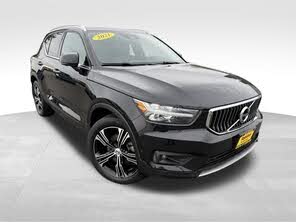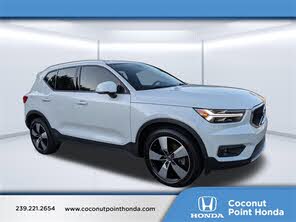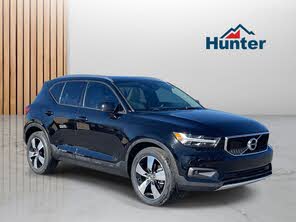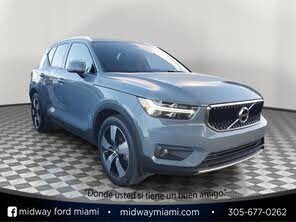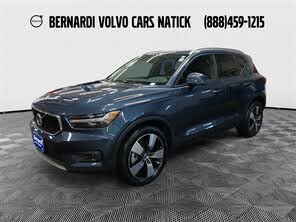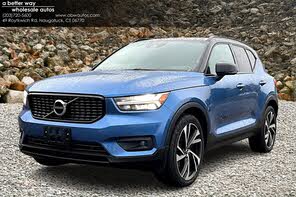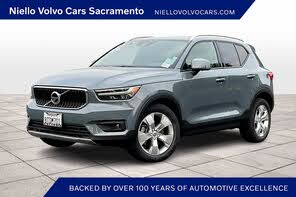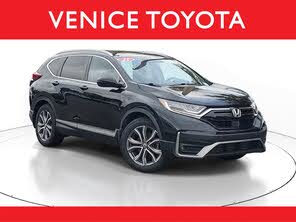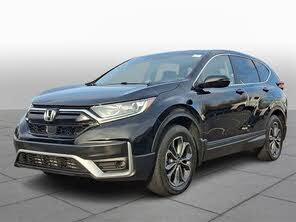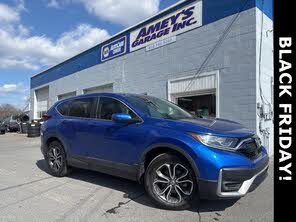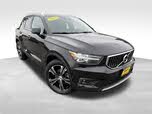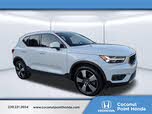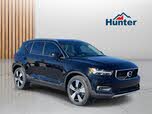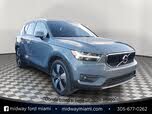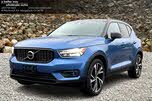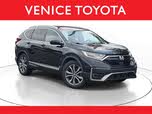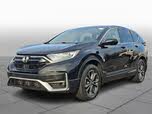2021 Volvo XC40 vs 2021 Honda CR-V
Overview | |
MSRP$33,700 | MSRP$25,350 |
Listings158 | Listings1266 |
Ratings & Reviews | |
User Reviews | User Reviews |
Expert reviews8.0 out of 10 | Expert reviews7.8 out of 10 |
Pros
Cons
| Pros
Cons
|
2021 Volvo XC40 Reviews SummaryIntroduced for the 2019 model year, the Volvo XC40 enters 2021 with one major change—the addition of an all-electric powertrain option. The 2021 Volvo XC40 Recharge is the Swedish automaker’s first mass-market electric vehicle, in fact. The Recharge will be sold alongside gasoline versions of the XC40, which carry over largely unchanged, and compete against small luxury crossovers like the Audi Q3, BMW X1, Mercedes-Benz GLA-Class, and Lexus UX. With its electric powertrain, the Recharge is a de facto Tesla Model Y competitor. It’s also priced similar to high-end versions of the Ford Mustang Mach-E, although the two electric crossovers have somewhat different philosophies. In addition to that zero-emission powertrain, the Recharge gets an Android-based operating system, over-the-air (OTA) software update capability for all vehicle systems, and some updates to driver-assist tech. These changes don’t apply to gasoline 2021 XC40 models, but Volvo does plan to add the Android operating system to more vehicles in the future. Since the Recharge is the main new thing for the 2021 XC40, that’s what we focused on for this review. While the gasoline XC40 is available in three trim levels—Momentum, R-Design, and Inscription—with front-wheel drive (FWD) or all-wheel drive (AWD), the Recharge is only offered in a single trim level, with standard AWD. | |
2021 Honda CR-V Reviews SummaryEven in a grim year, Honda is selling a staggering number of CR-Vs. The CR-V is the best-selling Honda by far. It’s also the second best-selling compact SUV, just behind the Toyota RAV4. And it's the fifth best-selling vehicle in the U.S., and if you take out all the commercial sales of full-size pickups it’s one of the two best-selling vehicles year in and year out. So it’s hard to argue against the CR-V formula. Honda’s been at this almost as long as crossovers have been a thing, launching the CR-V in 1997—a year after the RAV4 debuted. The funny thing is, aside from sales volume, there’s only one thing the CR-V particularly excels at. Aesthetics are subjective, but it would be hard to argue the CR-V is the best looking vehicle in its class. It’s not the cheapest. It’s not the best equipped, especially at the middle to lower trim levels. It’s not the fastest, nor is it the quietest, or the most fuel efficient. It’s not even the most reliable, showing up nowhere in J.D. Power's Most Reliable list. So what makes it so appealing to American consumers? Let’s see if we can figure that out. | |
No video found | No video found |
Popular Features & Specs | |
Engine2.0L 187 hp I4 | Engine1.5L 190 hp I4 |
Drive TrainFWD | Drive TrainFWD |
Seating Capacity5 | Seating Capacity5 |
Horsepower187 hp @ 4700 rpm | Horsepower190 hp @ 5600 rpm |
MPG City23 | MPG City28 |
MPG Highway32 | MPG Highway34 |
Engine | |
Engine Name2.0L 187 hp I4 | Engine Name1.5L 190 hp I4 |
Torque221 lb-ft @ 1400 rpm | Torque179 lb-ft @ 2000 rpm |
Horsepower187 hp @ 4700 rpm | Horsepower190 hp @ 5600 rpm |
DrivetrainFWD | DrivetrainFWD |
Fuel Economy | |
MPG City23 | MPG City28 |
MPG Highway32 | MPG Highway34 |
Interior | |
Leather SeatsStandard | Leather Seats |
Seating Capacity5 | Seating Capacity5 |
Safety | |
Front Crash Overall5 | Front Crash Overall5 |
Side Crash Overall5 | Side Crash Overall5 |
Dimensions & Capacity | |
Cargo Space20.7 cu ft | Cargo Space39.2 cu ft |
Curb Weight3627 lbs | Curb Weight3337 lbs |
Height65.3 in | Height66.1 in |
Length174.2 in | Length182.1 in |
Width80.1 in | Width73.0 in |
Wheelbase106.4 in | Wheelbase104.8 in |
Maximum Payload1133 lbs | Maximum Payload1358 lbs |
Number of doors4 | Number of doors4 |
Maximum Towing Capacity3500 lbs | Maximum Towing Capacity1500 lbs |
Overview | ||
MSRP | $33,700 | $25,350 |
Listings | ||
Ratings & Reviews | ||
User reviews | ||
Expert reviews | 8.0 out of 10Read full review | 7.8 out of 10Read full review |
Pros & cons | Pros
Cons
| Pros
Cons
|
Summary | Introduced for the 2019 model year, the Volvo XC40 enters 2021 with one major change—the addition of an all-electric powertrain option. The 2021 Volvo XC40 Recharge is the Swedish automaker’s first mass-market electric vehicle, in fact. The Recharge will be sold alongside gasoline versions of the XC40, which carry over largely unchanged, and compete against small luxury crossovers like the Audi Q3, BMW X1, Mercedes-Benz GLA-Class, and Lexus UX. With its electric powertrain, the Recharge is a de facto Tesla Model Y competitor. It’s also priced similar to high-end versions of the Ford Mustang Mach-E, although the two electric crossovers have somewhat different philosophies. In addition to that zero-emission powertrain, the Recharge gets an Android-based operating system, over-the-air (OTA) software update capability for all vehicle systems, and some updates to driver-assist tech. These changes don’t apply to gasoline 2021 XC40 models, but Volvo does plan to add the Android operating system to more vehicles in the future. Since the Recharge is the main new thing for the 2021 XC40, that’s what we focused on for this review. While the gasoline XC40 is available in three trim levels—Momentum, R-Design, and Inscription—with front-wheel drive (FWD) or all-wheel drive (AWD), the Recharge is only offered in a single trim level, with standard AWD. | Even in a grim year, Honda is selling a staggering number of CR-Vs. The CR-V is the best-selling Honda by far. It’s also the second best-selling compact SUV, just behind the Toyota RAV4. And it's the fifth best-selling vehicle in the U.S., and if you take out all the commercial sales of full-size pickups it’s one of the two best-selling vehicles year in and year out. So it’s hard to argue against the CR-V formula. Honda’s been at this almost as long as crossovers have been a thing, launching the CR-V in 1997—a year after the RAV4 debuted. The funny thing is, aside from sales volume, there’s only one thing the CR-V particularly excels at. Aesthetics are subjective, but it would be hard to argue the CR-V is the best looking vehicle in its class. It’s not the cheapest. It’s not the best equipped, especially at the middle to lower trim levels. It’s not the fastest, nor is it the quietest, or the most fuel efficient. It’s not even the most reliable, showing up nowhere in J.D. Power's Most Reliable list. So what makes it so appealing to American consumers? Let’s see if we can figure that out. |
Video | No video found | No video found |
Popular Features & Specs | ||
Engine | 2.0L 187 hp I4 | 1.5L 190 hp I4 |
Drive Train | FWD | FWD |
Seating Capacity | 5 | 5 |
Horsepower | 187 hp @ 4700 rpm | 190 hp @ 5600 rpm |
MPG City | 23 | 28 |
MPG Highway | 32 | 34 |
Engine | ||
Engine Name | 2.0L 187 hp I4 | 1.5L 190 hp I4 |
Torque | 221 lb-ft @ 1400 rpm | 179 lb-ft @ 2000 rpm |
Horsepower | 187 hp @ 4700 rpm | 190 hp @ 5600 rpm |
Drivetrain | FWD | FWD |
Fuel Economy | ||
MPG City | 23 | 28 |
MPG Highway | 32 | 34 |
Interior | ||
Leather Seats | Standard | |
Seating Capacity | 5 | 5 |
Safety | ||
Front Crash Overall | 5 | 5 |
Side Crash Overall | 5 | 5 |
Dimensions & Capacity | ||
Cargo Space | 20.7 cu ft | 39.2 cu ft |
Curb Weight | 3627 lbs | 3337 lbs |
Height | 65.3 in | 66.1 in |
Length | 174.2 in | 182.1 in |
Width | 80.1 in | 73.0 in |
Wheelbase | 106.4 in | 104.8 in |
Maximum Payload | 1133 lbs | 1358 lbs |
Number of doors | 4 | 4 |
Maximum Towing Capacity | 3500 lbs | 1500 lbs |
The 2021 Volvo XC40 was a standout in terms of design among small luxury crossovers. Its traditional SUV styling featured a tall and flat roof, combined with an upright rear hatch, giving it a more robust appearance than many of its rivals. Key Volvo family design cues included the distinctive “Thor’s Hammer” LED headlights and a simple oval grille. Gasoline models of the XC40 were available with a white contrasting roof, adding a touch of retro flair to its overall look.
The XC40 Recharge was visually distinguished from its gasoline counterparts by its blanked-off grille, subtle “Recharge” badging, and model-specific alloy wheels, with 19-inch wheels standard and 20-inch wheels optional. It also featured a gloss black roof and mirror caps, a slightly different rear bumper to accommodate the lack of exhaust tips, and a model-exclusive color—Sage Green Metallic. Its charging port replaced the traditional fuel filler location, retaining a largely familiar SUV appearance while catering to the electric vehicle segment.
The XC40's exterior housed the Compact Modular Architecture (CMA) platform, shared with the Polestar 2 electric vehicle. This platform was versatile enough to support both gasoline and electric powertrains, ensuring engineering integrity and performance.
Inside, the XC40 showcased a minimalist design adorned with high-quality materials, exuding a premium feel. Real metal trim on the dashboard and a blend of Nappa leather and Nubuck textile for upholstery highlighted the cabin. The interior design was cohesive, with a portrait-oriented touchscreen and well-integrated air vents, setting a high standard for luxury in this segment.
The 2021 Honda CR-V, while competent, had a more conventional and less distinctive aesthetic compared to its peers. Many compact crossover SUVs shared a similar “daylight opening”—the shape of the side window—making the CR-V difficult to distinguish from others on the road. Some unique elements like the grille opening and scattered chromed plastic features provided slight differentiation, but overall, the CR-V's exterior did not stand out.
Honda's color palette for the CR-V included eight options, but many of these were various shades of gray, black, or white. Vibrant colors like Aegean Blue Metallic and Radiant Red Metallic were reserved for higher trims. In practice, most CR-Vs found on dealer lots were of the more subdued white or gray varieties, making colorful options a rarity.
Inside, the CR-V offered a range of upholstery options—from cloth to leather—depending on the trim level. Higher trims featured additional luxury touches like wood panels and chrome details, aiming for a more upscale appearance. The seating was angular and modern, though perhaps less plush compared to some competitors.
Overall, the CR-V's design leaned heavily on functionality and practicality, rather than making a bold visual statement.

















Volvo provided a versatile powertrain lineup for the 2021 XC40. The gasoline options included a 2.0-liter turbocharged four-cylinder engine paired with an eight-speed automatic transmission. The front-wheel-drive T4 variant delivered 187 horsepower and 221 pound-feet of torque, while the all-wheel-drive T5 variant boosted these figures to 248 hp and 258 lb-ft.
At the top of the range, the XC40 Recharge employed a dual-motor setup with an electric motor on each axle, producing a combined 402 hp and 486 lb-ft of torque. This powertrain was supported by a 78-kilowatt-hour battery pack, with 75 kWh usable capacity. The vehicle’s performance was impressive, with a sprint from zero to 60 mph in just 4.7 seconds, making it faster than many competitors in the electric vehicle segment.
Volvo limited the top speed to 112 mph across all XC40 models, as part of a company-wide safety initiative. The gasoline T5 model could accelerate from zero to 60 mph in 6.1 seconds, while the T4 model took 8.1 seconds.
The XC40 Recharge emphasized luxury and comfort over high performance, with features like one-pedal driving and excellent ride quality even on rough roads. Its towing capacity was a notable 2,000 pounds, when properly equipped—a rarity among electric vehicles of its class.
The 2021 Honda CR-V was not engineered for high performance but aimed to provide reliable and steady driving characteristics. Every CR-V trim shared the same 190-horsepower turbocharged four-cylinder engine, paired with a continuously variable transmission (CVT). This setup provided smooth acceleration, and contemporary road tests suggested a zero to 60 mph time of about 7.8 seconds.
Unlike the Volvo XC40, which offered multiple powertrain options, the CR-V focused on a singular, balanced approach. The CVT, while efficient, did not provide the driving engagement found in some competitors with more conventional automatic transmissions. Rivals like the Kia Sportage and Hyundai Tucson offered eight-speed automatic transmissions that enhanced the driving experience.
The CR-V was available in front-wheel drive as standard, with an all-wheel-drive option for those who required extra capability. Honda’s unitized body structure, combined with MacPherson strut front suspension and a multi-link rear setup, ensured decent handling and ride quality, consistent with expectations for a vehicle in this class.
Volvo claimed that both gasoline and electric versions of the XC40 offered the same passenger and cargo space. Despite this, the XC40 Recharge was less spacious compared to competitors like the Tesla Model Y and Ford Mustang Mach-E, particularly in terms of front and rear legroom, headroom, and cargo area. The frunk, or front trunk, of the XC40 Recharge was minimal, largely occupied by powertrain components.
In gasoline form, the XC40 fared better against rivals such as the Audi Q3 and BMW X1 concerning interior space, although the segment’s overall utility was generally modest.
Volvo compensated for its space constraints with smart storage solutions. The center console featured a removable trash bin and a bag hook integrated into the glovebox door. Harmon Kardon system speakers were relocated from the doors to the dashboard, creating larger door bins. The storage cubby ahead of the shifter was designed to securely hold a phone. Front occupants could opt for a wireless charging pad, while rear passengers unfortunately lacked phone charging options.
The Honda CR-V excelled in maximizing form and function, maintaining its longstanding objective of accommodating five passengers comfortably while providing ample cargo space. The CR-V offered 102.9 cubic feet of passenger volume, slightly surpassing the Toyota RAV4. It also provided a bit more cargo space behind the second row compared to the Toyota, with a total cargo volume of 75.8 cubic feet when the rear seats were folded.
The CR-V’s cargo area access varied by trim. Lower trims required manual operation of the tailgate, while higher trims such as the EX-L featured a power tailgate, and the Touring offered a hands-free version activated by a foot motion under the bumper. Roof rails, necessary for additional cargo carrying, were only standard on the top-tier Touring trim, although competitors like Subaru offered these features at lower prices.
The 2021 Volvo XC40 Recharge was equipped with the Android Automotive OS infotainment system, originally introduced in the Polestar 2. This system heavily integrated Google services, including Google Assistant for voice control and Google Maps for navigation. Android phone users could sync their Google accounts for enhanced customization. The 9-inch touchscreen and 12.3-inch digital instrument cluster delivered top-notch graphics and intuitive menu layouts, though the interface might not appeal to all drivers.
Volvo also included conventional Apple CarPlay, Android Auto, and Bluetooth connectivity as standard. The Recharge model offered over-the-air (OTA) update capability, allowing Volvo to push updates for various vehicle functions, similar to Tesla, although Volvo’s plans for future updates remained unspecified.
Interestingly, the XC40 Recharge did not have a traditional start button. Drivers only needed the key fob to be present, and shifting out of park activated the car. Although related to the Polestar 2’s Digital Key feature, Volvo had not confirmed this function for the XC40.
The base 2021 Honda CR-V LX featured a basic 5-inch color screen with Bluetooth connectivity. However, higher trims from the Special Edition onwards included a 7-inch high-definition touchscreen infotainment system with Apple CarPlay and Android Auto integration, plus SMS text messaging functions. The audio system varied by trim, with the Special Edition and EX offering a 180-watt system with six speakers, while the EX-L added two additional speakers. The Touring model boasted a 300-watt system with a subwoofer.
Most trims, except the base LX, included multiple charging ports: 1-amp and 1.5-amp USB ports in the front console, a 12-volt outlet in the center console, and 2.5-amp USB ports in the second row. The Touring trim added a wireless phone charger for added convenience.
The 2021 Volvo XC40 gasoline models received top ratings for safety, earning the IIHS “Top Safety Pick+” and a five-star overall rating from NHTSA. These accolades underscored the vehicle's crashworthiness and overall safety performance, although the XC40 Recharge had not been rated due to its different structure. Volvo anticipated strong safety results for the Recharge, thanks to robust structural reinforcements and a dedicated safety cage around the battery.
Standard safety features in the XC40 included lane-keep assist, blind-spot monitoring with rear cross-traffic alert, automatic emergency braking, rear parking sensors, hill-start assist, and hill-descent control. Optional enhancements incorporated traffic-sign recognition, reverse automatic emergency braking, driver-alertness monitoring, run-off road mitigation, oncoming lane mitigation, and the Pilot Assist system, combining adaptive cruise control with lane centering.
The Recharge model also benefited from Volvo's latest sensor suite and related software, setting the stage for future advanced driver assistance features.
The 2021 Honda CR-V excelled in safety, earning both the NHTSA five-star overall rating and the IIHS Top Safety Pick award, though it narrowly missed the Top Safety Pick+ designation due to variances in headlight performance and side crash test updates. The CR-V's LATCH child seat anchoring system also received a less-than-perfect “Acceptable” rating for ease of use.
Honda’s commitment to safety was evident in how it equipped the CR-V across its trims. All advanced safety features were standard under Honda’s Sensing system, irrespective of trim level. Standard features included a multi-angle rearview camera, forward collision warning, lane departure warning, automatic emergency braking, road departure mitigation, lane keeping assist, adaptive cruise control, and auto high-beam headlamps. Blind spot monitoring with rear cross-traffic alert was exclusive to the EX trim and above.
CarGurus highlights
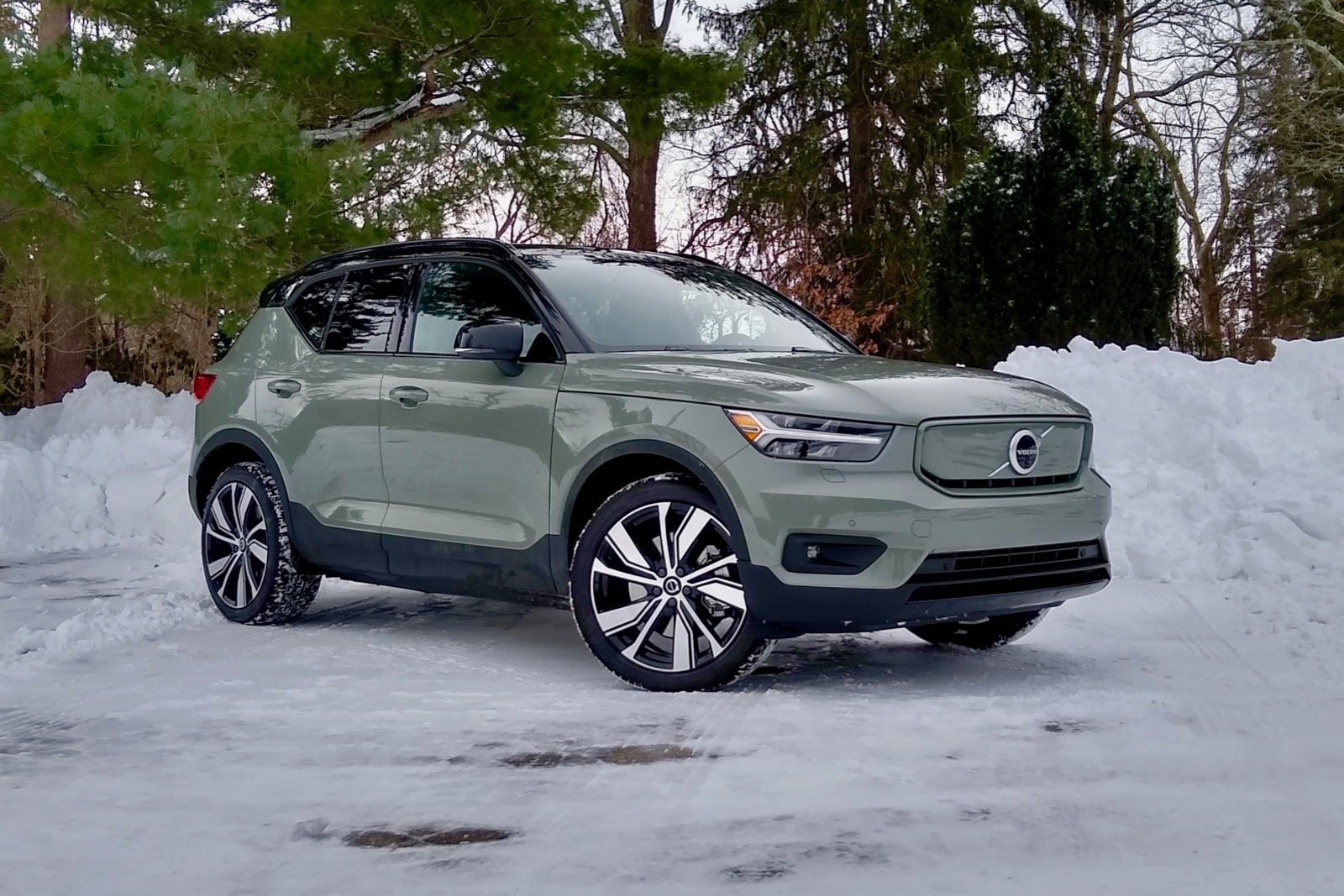
According to CarGurus experts, the overall rating for the 2021 Volvo XC40 was 8.0 out of 10, while the 2021 Honda CR-V scored 7.8 out of 10. Based on these ratings, the Volvo XC40 emerges as the slightly superior choice, offering a more premium interior, multiple powertrain options, including an electric version, and extensive safety features. The Honda CR-V remains a strong contender for those prioritizing practical space and comprehensive standard safety equipment, but the XC40 holds a slight edge overall.
Choose the 2021 Volvo XC40 if:
- You prioritize a premium, high-quality interior with minimalist design and cohesive elements.
- You prefer multiple powertrain options, including a powerful and efficient electric variant.
- You seek a vehicle with advanced safety features and OTA update capability for future enhancements.
Choose the 2021 Honda CR-V if:
- You need a practical vehicle with ample passenger and cargo space.
- You want standard advanced safety features across all trims, providing value and peace of mind.
- You seek a reliable and efficient vehicle for everyday use, with straightforward functionality over luxury frills.
CarGurus highlights

According to CarGurus experts, the overall rating for the 2021 Volvo XC40 was 8.0 out of 10, while the 2021 Honda CR-V scored 7.8 out of 10. Based on these ratings, the Volvo XC40 emerges as the slightly superior choice, offering a more premium interior, multiple powertrain options, including an electric version, and extensive safety features. The Honda CR-V remains a strong contender for those prioritizing practical space and comprehensive standard safety equipment, but the XC40 holds a slight edge overall.
Choose the 2021 Volvo XC40 if:
Shop Now- You prioritize a premium, high-quality interior with minimalist design and cohesive elements.
- You prefer multiple powertrain options, including a powerful and efficient electric variant.
- You seek a vehicle with advanced safety features and OTA update capability for future enhancements.
Choose the 2021 Honda CR-V if:
Shop Now- You need a practical vehicle with ample passenger and cargo space.
- You want standard advanced safety features across all trims, providing value and peace of mind.
- You seek a reliable and efficient vehicle for everyday use, with straightforward functionality over luxury frills.

By: CarGurus + AI
At CarGurus, our team of experienced automotive writers remain at the heart of our content operation, conducting hands-on car tests and writing insightful guides that are backed by years of industry experience. To complement this, we are harnessing AI to make our content offering more diverse and more helpful to shoppers than ever. To achieve this, our AI systems are based exclusively on CarGurus content, ratings and data, so that what we produce is both unique to CarGurus, and uniquely helpful to car shoppers.

